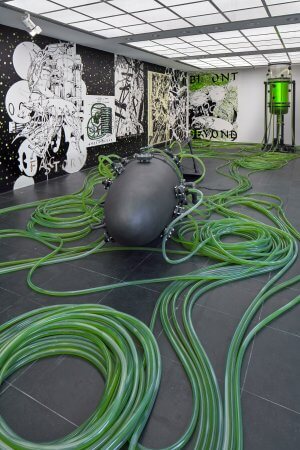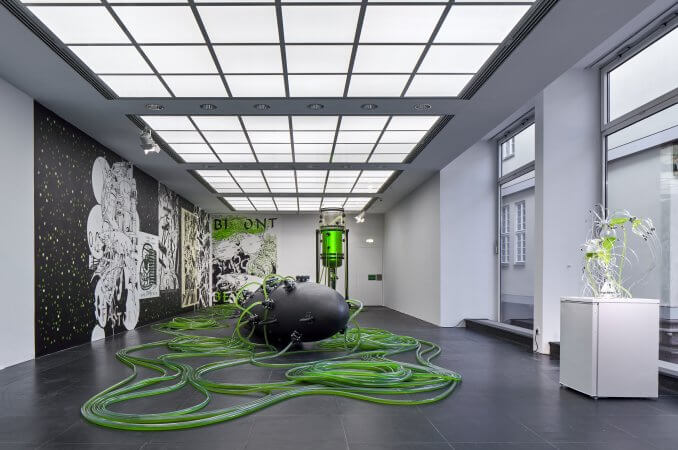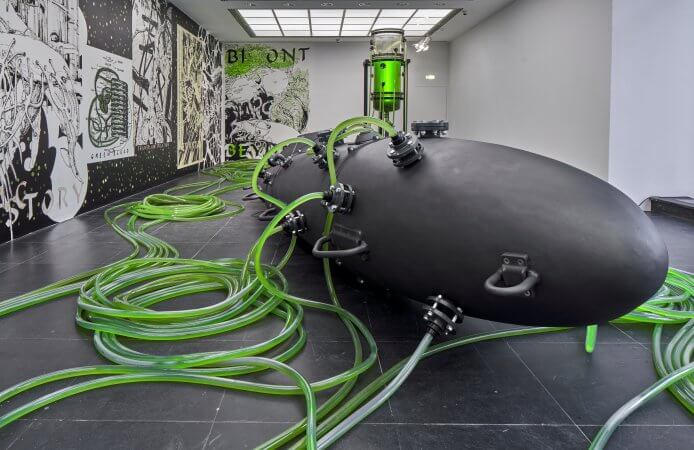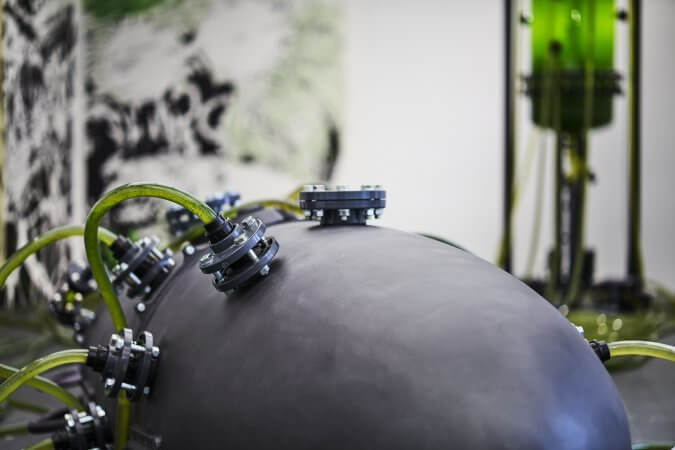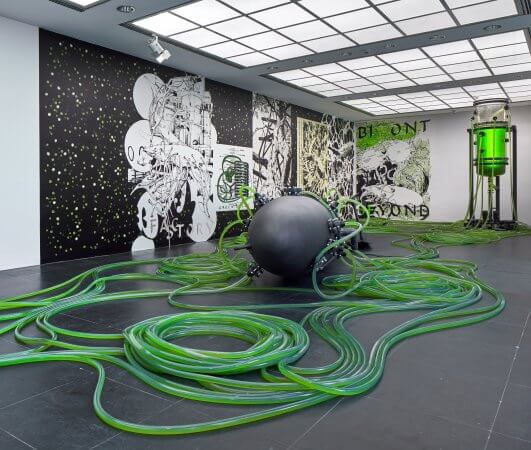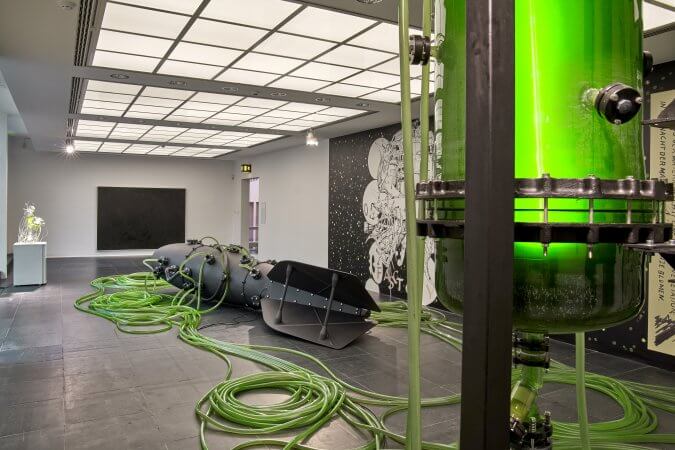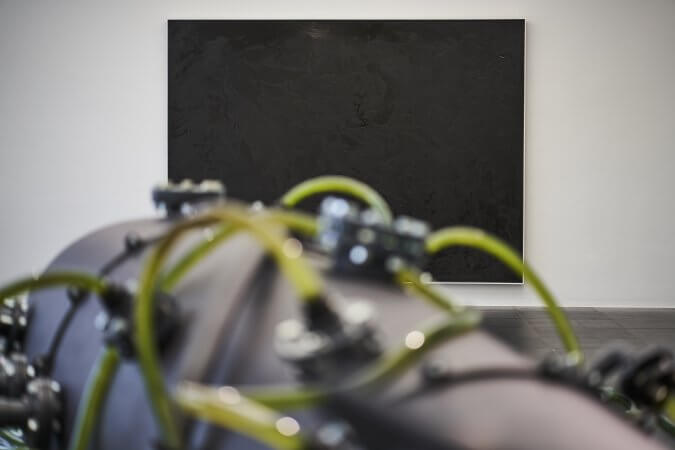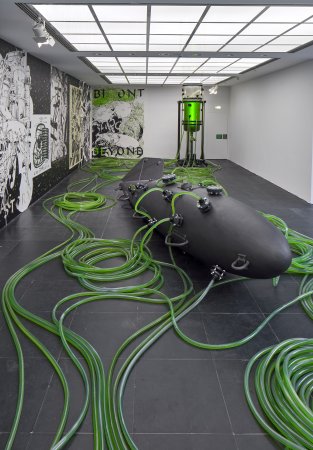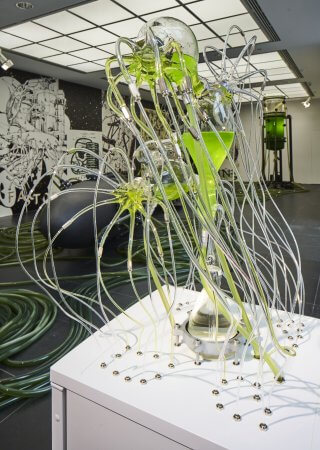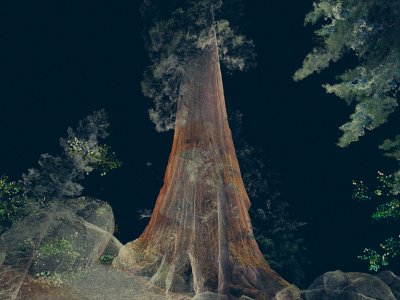Thomas Feuerstein
Hydra, 2021
Green algae (Chlorella vulgaris), plastic, steel, glass, pumping system, bioreactor made of glass, steel, pumping technology, PVC tubes, light element
110 x 110 x 495 cm; 315 x 100 x 100 cm (Bioreactor)
With the kind support of Muffathalle München
Green Hydra, 2021
Hydra (many-headed Hydra viridissima), glass, plastic, pump technology, refrigerator
170 x 72 x 57 cm
Harvest, 2007
Carbonized algae and synthetic resin on wood
200 x 270 cm
Green Blood, 2021
Wall graphic
325 x 250 cm; 325 x 1137 cm
Courtesy of the artist and Galerie Elisabeth & Klaus Thoman
Thomas Feuerstein is a universal artist who pursues philosophy, writes literary and science fiction texts, conceives scientific experimental set-ups and uses laboratory methods to extract raw materials which he uses to create painterly and sculptural works. For almost thirty years, he has worked at the intersection of all these disciplines, exploring the interaction of science, art, and being interested in the overarching questions of human existence.
Hydra is his new spatial installation. It is a closed system powered by a photobioreactor, reminiscent of a submarine or whale, that dominates the space. Connected to the metal form are numerous tubes from which a green liquid is pumped, a preparation of water and living green algae (Chlorella vulgaris). The polyurethane tubes, which are over 1000 meters long, are transparent so that the living organisms receive light to carry out the photosynthesis that is vital for them.
Chlorella vulgaris is used again and again in Feuerstein’s works. This microalgae is a model organism in botany that is cultivated in large numbers in the laboratory to be used as a test object for biological, medical and biotechnological research. From the very beginning of its research, concepts were developed for its use as food, and later as an energy source and biomass in bioeconomic production.
Feuerstein’s Hydra photoreactor is part of a cycle to filter, dry and then carbonise the living material algae. This process takes place over millions of years in the natural formation of coal, but is extremely concentrated in time and space by human technology and its quest for use. From the black pigment obtained, the artist presses pencils with which he produces drawings and paintings. In the exhibition, the painting Ernte (Harvest) is presented. As is often the case with Feuerstein, terms are borrowed from productive and economic contexts. For economy, according to the artist, is a fundamental principle of living together and community building. Both on a microbiological level and in human communities. The process of metabolism repeatedly serves Feuerstein as a model of a principle of life. Just as the end product of the chemical transformation of one cell serves as building material for another, Feuerstein elevates this real process to a metaphorical model of thought. His works are not passive objects but autonomous agents. Real transformations take place in them, metabolic processes that must be kept alive for the duration of the exhibition.
The Green Hydra is a handmade glass sculpture that contains the creatures whose outer form it magnifies. Microscopic jellyfish live in a liquid and enter into a symbiotic relationship with chlorella algae. Inside their transparent bodies, you can see the green pigment of the microalgae. Both organisms enable each other to live through their different metabolic processes. In recent years, symbiotic partnerships have taken on a metaphorical significance in the debate about new models of society. Lynn Margulis, in her book Symbiotic Planet (1998), applied biochemical observations to human life forms and championed these intellectual abstractions across disciplines. She emphasised the ability of plant life to connect with its environment through cooperation with other species, so that the life of different species remains in a permanent balance.
Feuerstein has also been working interdisciplinarily for years with a team of biochemists, physicists and microbiologists from various universities. Feuerstein uses biochemical processes in his living installations with a high level of scientific and engineering competence. He enhances these experimental arrangements with his knowledge of the humanities. The titles of the works refer to ancient narratives. The Hydra, the many-headed monster of Greek mythology, which grows two heads when one is cut off, stands today as a parable for constellations in which every attempt at containment or suppression only leads to an escalation.
Natural science and art combine the potential to develop new ideas about reality. Where the sciences formulate a thesis that has to be objectively proven by developing experiments, art asserts the hypothesis and builds a model of thought on it that is carried into the public discourse with an open mind. The fiction emerges as a publicly negotiable image that can initiate a social debate.
Thomas Feuerstein (*1968, Innsbruck, AT) lives and works in Vienna (AT). He studied art history and philosophy at the University of Innsbruck (AT), where he also received his PhD. His artistic practice combines phenomena from philosophy, art history and literature with biotechnology, economics and politics into artistic narratives. His works include installations, processual sculptures, drawings, radio plays, bio- and net art. Since 1997 Feuerstein has been a lecturer and visiting professor at universities and art colleges, currently professor of artistic discourse at the Institute for Experimental Architecture/studio3 at the University of Innsbruck (AT). Among others, Thomas Feuerstein has exhibited in the following institutions: 15th Biennale de Lyon (FR), 6. Guangzhou Triennial (CN), Moscow Museum of Modern Art, Moscow (RU), Kunstraum Dornbirn (AT), ERES Foundation, Munich (DE), Medical Museion, Copenhagen (DK), Chronus Art Center, Shanghai (CN), Galerie im Taxispalais, Innsbruck (AT), Kunstverein Heilbronn (DE), ZKM Zentrum für Kunst und Medien, Karlsruhe (DE), Palazzo Strozzi, Florence (IT).

